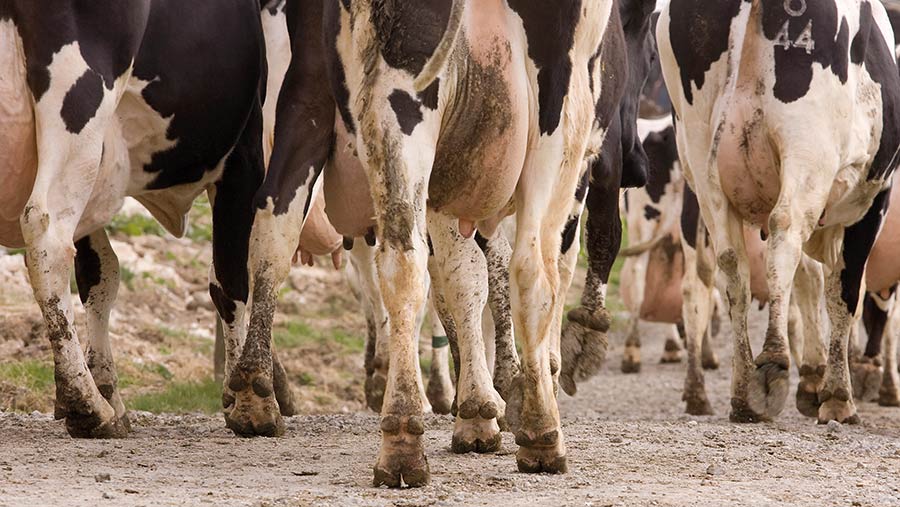Why low-cost devices can be effective to detect lameness
 © MAG/Jonathan Page
© MAG/Jonathan Page Low-cost thermal imaging devices are as effective at detecting lameness in dairy cattle as expensive alternatives, a study led by the Royal Veterinary College (RVC) has revealed.
Infrared thermal imaging (IRT) devices are typically high in cost and have limited adoption, but the effectiveness of cheaper tools that cost 2% of expensive ones could result in wider use among farmers, vets and hoof trimmers.
This could help to identify lameness earlier, researchers concluded.
See also: Why genetics can play bigger role in breeding out lameness
What is infrared thermal imaging (IRT)?
IRT is a non-invasive procedure that does not require any devices to be attached to the cow.
Factors affecting the quality of thermograms are resolution, thermal sensitivity and accuracy.
The better these are, the higher the cost of the device, with some cameras costing up to £20,000. This makes it uneconomical for many farms and creates a huge barrier to uptake.
There are now cheaper, lower-specification devices on the market, but these have been untested for lameness detection up until now.
About the study
The hind feet of 83 Holstein-Friesians were assessed four times over a two-week period during morning milkings.
Lame limbs have a higher temperature than healthy ones owing to increased inflammation, which increases the blood flow and surface temperature.
Researchers compared the environmental temperature with the hind-feet temperature from both high- and low-cost thermal imaging devices (see “Cameras compared”).
Environmental temperature can affect the average foot temperature.
One method used to account for this difference is identification of normal foot temperature values at different ambient temperatures; the other is to compare the difference in temperature between a cow’s limbs.
A previous study found IRT devices had a marked drop in maximum temperature recorded at a larger distance from target.
Therefore, temperature was recorded at a one-metre distance, which provided more reliable results.
Mobility scores were also conducted (see “AHDB mobility scoring criteria”) to compare the effectiveness of each device at identifying lame cows.
Cameras compared |
|||||
|
Camera |
Resolution (pixels) |
Temperature sensitivity |
Temperature range |
Accuracy |
Approximate cost (£) |
|
CAT s62-Pro Smartphone |
160×120 |
Less than 0.05 |
-20 to 400 |
3% or 3C |
£400 |
|
Flir t620bx |
640×480 |
Less than 0.04 |
-40 to 650 |
2% or 2C |
£20,000 |
Results
RVC undergraduate veterinary student Aidan Coe led the study alongside Nicola Blackie, a senior lecturer in production animal science at the RVC.
They concluded there was very little difference in the performance and quality of the devices despite the low-cost device being just 2% the cost of the high-cost device.
“Despite the high-cost device costing thousands, the difference between the two was minimal – about 4-5%,” explains Mr Coe.
The higher-definition camera was slightly better at detecting lame limbs, likely owing to its higher resolution and improved thermogram detail.
However, Dr Blackie says this did not matter. She explains: “We are not looking for accuracy – we are looking for differences.”
The cow’s body should be equal and, when a foot is lame, this changes and allows the camera to detect the difference, she adds.
If the temperature is 1.85C hotter than the opposite foot, the chances are the hotter foot is lame, adds Mr Coe.
Neither device could distinguish between mobility scores 0 and 1, or scores 2 and 3, suggesting IRT temperature does not have an exact correlation with lameness severity, although it does differentiate between those classified as lame and sound.
Previous research suggest this can be caused by mobility scoring subjectivity and the type of lesion present, with digital dermatitis, for example, causing more inflammation compared with other issues.
However, this does not affect the effectiveness of IRT, as intervention is only advised if an animal scores 2 or above.
What it means for on-farm use
Mr Coe says the study shows low-cost devices have the potential to be used as lameness detection aids alongside mobility scoring on farm to identify lameness earlier.
However, he believes the technology must first be tested on more farms – something he hopes to continue as part of his vet training.
He says apps could help streamline lameness detection by automatically comparing feet and referencing the environmental temperature. This would avoid farmers becoming “bogged down” in data, he adds.
The AHDB mobility scoring criteria |
||
|
AHDB lameness score |
Criteria |
Suggested response |
|
0 |
|
Routine trim if needed |
|
1 |
|
Routine trim when needed and further observation |
|
2 |
|
Lift foot to establish cause, and treat |
|
3 |
|
Urgent attention required |
